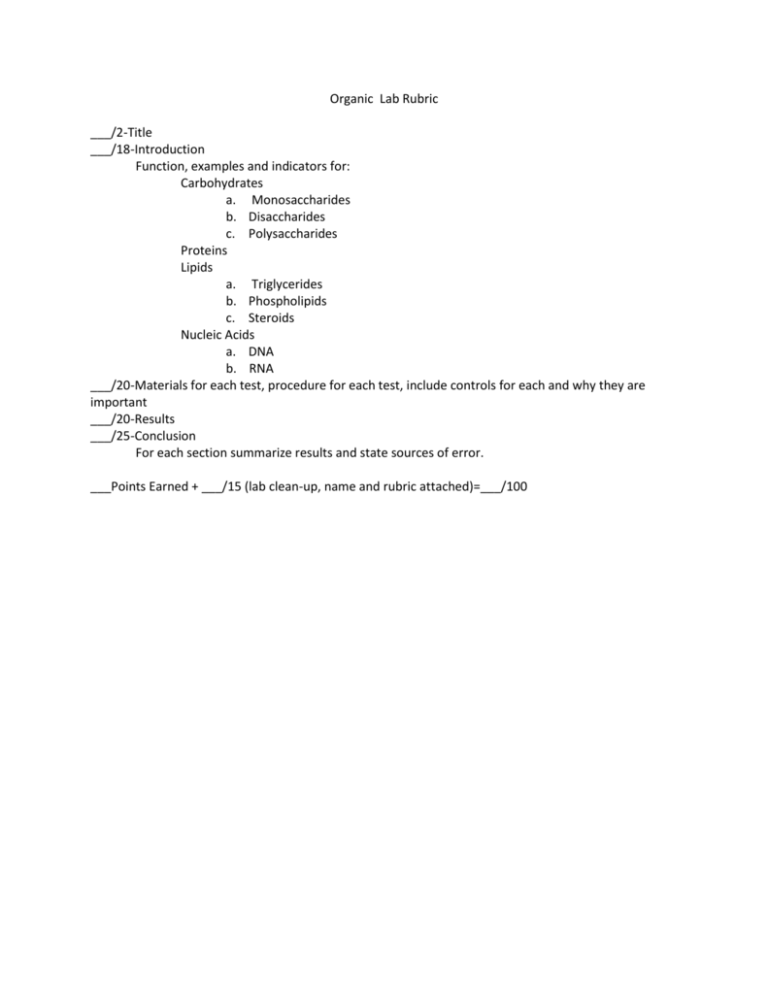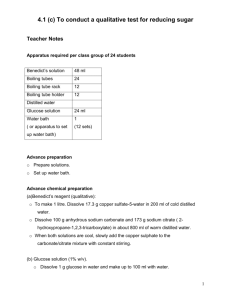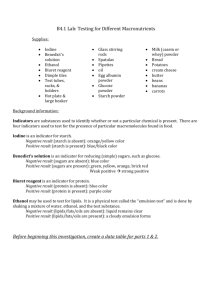Organic lab
advertisement

Organic Lab Rubric ___/2-Title ___/18-Introduction Function, examples and indicators for: Carbohydrates a. Monosaccharides b. Disaccharides c. Polysaccharides Proteins Lipids a. Triglycerides b. Phospholipids c. Steroids Nucleic Acids a. DNA b. RNA ___/20-Materials for each test, procedure for each test, include controls for each and why they are important ___/20-Results ___/25-Conclusion For each section summarize results and state sources of error. ___Points Earned + ___/15 (lab clean-up, name and rubric attached)=___/100 Biologically Important Molecules Carbohydrates, Proteins, Lipids and Nucleic Acids Objectives: By the end of this exercise you should be able to: 1. Understand how to test for the presence of carbohydrates, lipids, proteins and nucleic acids. 2. Understand the importance of a control in biochemical tests. 3. Use biochemical tests to identify an unknown compound. Most organic compounds in living organisms can be classified as carbohydrates, proteins, lipids, or nucleic acids. Each of these macromolecules are made of smaller subunits (Figs 2-1, 2-2, 2-3 and 2-4). These subunits of macromolecules are held together with covalent bonds, and have different structures and properties. For example, lipids made of fatty acids have many C-H bonds and relatively little oxygen, while proteins made of amino acids have amino groups (-NH2) and carboxyl (-COOH) groups. These characteristic groups impart different chemical properties to macromolecules-for example, monosaccharides such as glucose are polar and soluble in water, while lipids are nonpolar and insoluble in water. Controlled Experiments to Identify Organic Compounds Scientists have devised several biochemical tests to identify the major types of organic compounds in living organisms. Each of these tests involves two or more treatments; an unknown solution to be identified and controls. As its name implies, an unknown solution may or may not contain the substance that the investigator is trying to detect. Only a carefully conducted experiment will reveal its contents. In contrast, controls are known solutions. We use controls to validate that our procedure is indeed detecting what we expect it to detect and nothing more. During the experiment we compare the unknown solution’s response to the experimental procedure with the control’s response to that procedure. A positive control contains the variable for which you are testing. It reacts positively and demonstrates the test’s ability to detect what you expect. For example, if you are testing for protein in unknown solutions, then an appropriate positive control is a known solution of protein. A positive reaction proves that your test reacts correctly, and shows you exactly what a positive test looks like. A negative control does not contain the variable for which you are searching. It contains only the solvent (often distilled water with no solute) and does not react in the test. A negative control shows you what a negative result looks like. Controls are important because they allow us to determine the specificity of a particular test. For example, if water and glucose solution react similarly in a particular test, then the test cannot distinguish water from glucose. However, if the aqueous solution of glucose reacts differently from distilled water, then the test can distinguish water from glucose. In this instance, the distilled water would be a negative control for the test and a known glucose solution would be a positive control. Procedures CARBOHYDRATES Benedict’s Test for Reducing Sugars Carbohydrates are molecules made of C, H and O in a ratio of 1:2:1 (ex, the chemical formula for glucose is C6H12O6). Carbohydrates are made of monosaccharides, or simple sugars (Fig 2-1). Paired monosaccharides form disaccharides-for example, sucrose is a disaccharide of glucose linked to fructose. Similarly, linking three or more monosaccharides form a polysaccharide such as starch, glycogen, or cellulose. Many monosaccharides such as glucose and fructose are reducing sugars, meaning that they possess free aldehyde (-CHO) or ketone (-C=O) groups that reduce oxidizing agents such as the copper in Benedict’s reagent. Benedict’s reagent contains cupric (copper) ion complexed with citrate in alkaline solution. Benedict’s test identifies reducing sugar based on their ability to reduce the cupric (Cu2+) ions to cuprous oxide at basic (high) pH. Cuprous oxide is green to reddish orange. Oxidized Benedict’s reagent (Cu2+) + Reducing sugar (R-COH) (blue) Heat High pH Reduced Benedict’s reagent (Cu+) + Oxidized sugar (R-COOH) (green to reddish orange) Green color indicates a small amount of reducing sugars, and reddish orange color indicates an abundance of reducing sugars. Non-reducing sugars such as sucrose produce no change in color (i.e., the solution remains blue). Materials: 7 test tubes Apple juice Test tube rack Lemon juice Labeling tape Yogurt Water Benedict’s solution Glucose solution Hot plate Regular soda Hot water bath Diet soda Test tube holder Procedure: 1. Obtain 7 test tubes and number them 1-7. 2. Add to each tube the materials to be tested Test tube 1-Water Test tube 2-Glucose solution Test tube 3-Diet soda Test tube 4-Regular soda Test tube 5-Apple juice Test tube 6-Lemon juice Test tube 7-yogurt 3. Add 2 ml of Benedict’s solution to each test tube. 4. Place all of the test tubes in a hot water bath for 3 minutes and observe color changes during this time. 5. After 3 minutes use a test tube holder to remove tubes and let them cool to room temperature. Record the color of their contents. Iodine Test for Starch Iodine (iodine-potassium iodide, I2KI) staining distinguishes starch from monosaccharides, disaccharides, and other polysaccharides. The basis for this test is that starch is a coiled polymer of glucose. Iodine interacts with these coiled molecules and becomes bluish black. Iodine does not react with other carbohydrates that are not coiled, and remains yellowish brown. Therefore, a bluish black color is a positive test for starch and a yellowish brown color (i.e. no color change) is a negative test for starch. Notably, glycogen, a common polysaccharide in animals has a slightly different structure than does starch and produces only an intermediate color reaction. Materials: 7Test tubes Pasta Test tube rack Glucose solution Water Soda Corn starch colution Yogurt Potato Iodine Procedure: 1. Obtain 7 test tubes and number them 1-7. 2. Add to each test tube the materials to be tested: Test tube 1-Water Test tube 2-Corn starch solution Test tube 3-Potato Test tube 4-Pasta Test tube 5-Glucose solution Test tube 6-Regular Soda Test tube 7-yogurt 3. Add 3-5 drops of iodine to each test tube. 4. Record the color of the tube’s contents in data table. PROTEIN Proteins are made of amino acids, each of which has an amino group (-NH3) and a carboxyl, or acid group (-COOH). The bond between these two groups found on adjacent amino acids in a protein is a peptide bond (Fig 2-2) and is identified with a Biuret test. Specifically, peptide bonds (C-N bonds) in proteins complex with Cu2+ in biuret reagent and produce a violet color. A Cu2+ion must complex with four to six peptide bonds to produce a color; therefore, free amino acids do not react positively. Long-chain polypeptide (proteins) have many peptide bonds and produce a positive reaction. Biuret reagent is a 1% solution of Cu SO4, copper sulfate. A violet color is a positive test for the presence of a protein, and the intensity of color is proportional to the number of peptide bonds reacting. Materials: 5 test tubes Test tube rack Water Protein solution Procedure: 1. Obtain 5 test tubes and number 1-5. 2. Add the materials listed to be tested: Test tube 1-Water Test tube 2-Protein solution Test tube 3-Tuna Test tube 4-Egg white Test tube 5-Yogurt 3. Add 10 drops of Biuret reagent to each tube. 4. Record the color of the tubes. Chicken Egg white Yogurt Biuret LIPIDS Lipids react with paper to make it translucent. A translucent spot after drying is a positive result. Materials: Brown paper bag Water Oil Butter Egg white Yogurt Procedure: 1. Obtain a sample of paper bag and label it with the 5 substances to be tested. 2. Place a small sample of each substance to be tested on the paper bag above the labeled spot and allow to try. Substance 1: water Substance 2: oil Substance 3: butter Substance 4: Egg white Substance 5: Yogurt 3. Record results. UNKNOWN: Test your unknown with all of the above tests and attempt to identify which of the 3 substances tested in the previous labs are contained in your unknown. Figure 2-1 Figure 2-2 Figure 2-3 Figure 2-4







